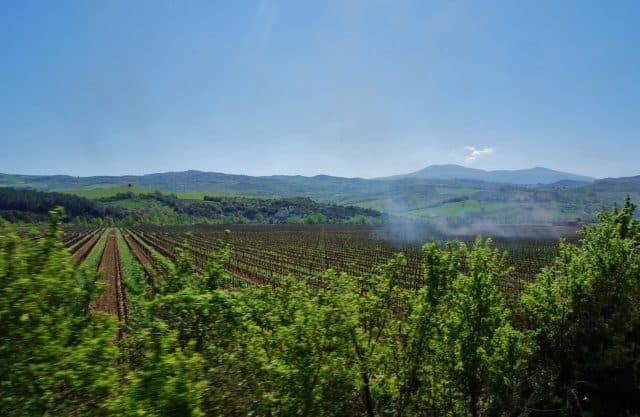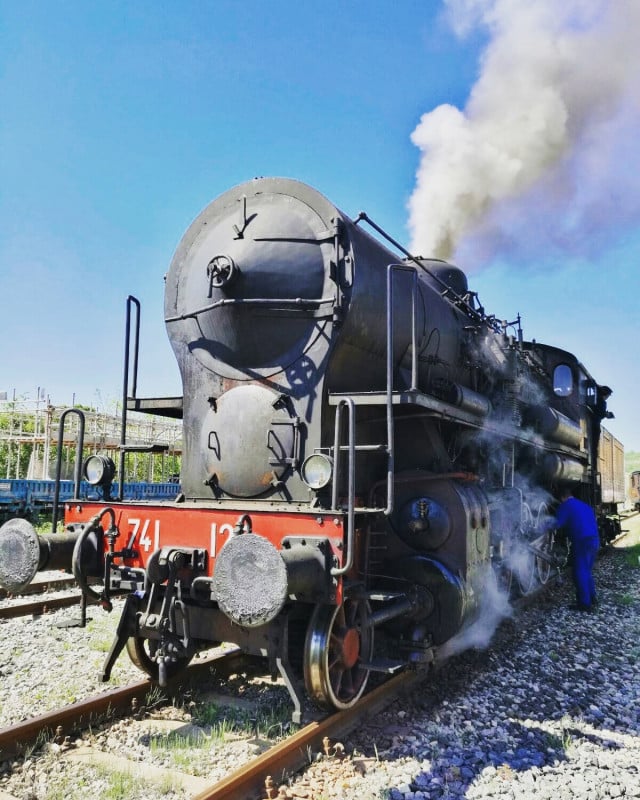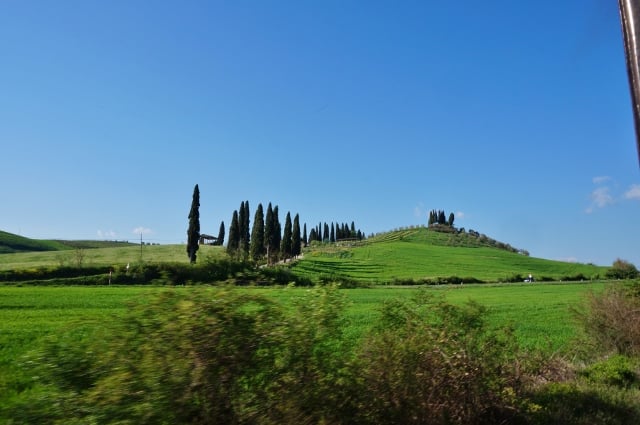Weekend Wanderlust: Siena and a steam train ride through wine country

One of the best ways to see Tuscany's legendary Val D'Orcia region is on the reopened steam railway running through fields, forests and vineyards.
Most of us see Tuscany’s famous rolling landscape from the road. Or maybe on foot, since walking holidays in the region have become so popular. But there’s a more unusual way to get your fix of stunning Tuscan landscape, without a motorway junction in sight.
In fact, from the open windows of the treno natura, a restored 1920s steam train, all I saw was rolling hills, wild woodland, and shimmering vineyards for hours.
.jpg)
The only signs of civilisation on the route between Siena and San Quirico d’Orcia were: the occasional green-shuttered villa or azienda vinicola (winery), and someone driving a vespa slowly down a winding cypress-lined hill.
The train trip had an important purpose. It was taking us from the famous Tuscan town of Siena to the village of San Quirico d’Orcia, in the heart of some of Italy’s most beloved wine country, for a local wine festival.

This little train goes to various impossibly beautiful villages all over the region every spring and autumn. To wine fairs, truffle festivals and all kinds of other very typical, usually food-oriented events, using old rail lines far from major towns, which would otherwise sit unused.
My trip was last April, on one of the first really hot and sunny weekends of the year. The train doesn’t run in summer or winter and there are very good reasons for that, as I soon found out.
.jpg)
The carriages in our train, called centoporte (hundred doors) since every section of each compartment had its own miniature door, had highly polished wooden seats, brass fixtures, and big windows that you could easily lean or fall out of.
This glamorous train, which probably fails to meet every last modern-day safety and environmental regulation in Europe, was built in the 1920s, with some parts of the carriage made of reclaimed material dating back to the previous century.
It was mostly used on the line from Venice to Turin and, incredibly, it remained in use until the mid-1980s.
I’d expected this old steam train to be a deafeningly noisy, bone-shaking ride but actually it was surprisingly smooth and quiet.
It was also very, very slow. This meant the only real risk involved in leaning out of the wide-open windows was getting a cloud of black, sooty steam in your face if the wind changed.
The day soon got very hot, and all the passengers were opening and closing those hundred little windows every few minutes in an hopeless attempt to stay cool without getting completely covered in soot. We all ended up with ash and assorted railway muck all over us, which didn't seem to dampen anyone's spirits.

Like most heritage railways – which are now becoming big business in many countries – this train is staffed and maintained by a group of jovial volunteers, mostly ex-railway staff, some of whom were well into their 80s but had no trouble cheerfully hopping up and down the steep steps.
They explained that the train costs a small fortune to run, which is why the tickets aren’t particularly cheap at 40 euros per person.
And it’s hard not to be concerned about the environmental cost of heritage railway projects; it was pretty disconcerting to see those black clouds billowing over the otherwise-pristine Tuscan countryside.
.jpg)
But these trains have a devoted following among those who, in the modern age, are exhilarated by this way of travelling.
On the trip, I met people who’d travelled from the Netherlands and France specifically to ride Italy’s vintage steam trains. It was clear that this trip meant a lot to them, as well as to the volunteers. The appeal is obvious even to non-experts like me.
We finally arrived, sooty, sweaty, but happy, at Torrenieri, the closest station to the village of San Quirico d’Orcia just before lunchtime.
.jpg)
San Quirico d’Orcia is a picture-postcard Tuscan town and it was lively with wine festival visitors when we arrived. The tastings were held inside the town hall, a grand building filled with frescoes, and on that weekend, dozens of stalls selling locally-produced wines.
The area’s tourist board is trying to promote Orcia wines, so there was a lot of focus on those. Winemakers insisted that Orcia is making a big name for itself, despite being a tiny DOC bordered by Vino Nobile di Montepulciano, Brunello, and the mighty Chianti region.
Quite a few wineries around nearby Montalcino, like Sasso di Sole, make their wines with the Orcia and Brunello grapes..jpg)
We emerged just in time to take the train back to Siena. A lot of passengers took buses for the return trip, so the train was half empty, and I watched that landscape roll by in a happy, somewhat sooty haze all the way back to Siena.
I find Siena too crowded even at this early point in the season, so I did some sightseeing by night and stayed at a rustic-style B&B outside of the centre at an 18th-century farmhouse called Gli Archi. I couldn’t recommend it enough for the quiet location, the warm welcome, and the huge breakfast - complete with (unusually) savoury options as well as an impressive array of homemade cakes.
My slow, sooty ride gave me a new appreciation for Italy's high-speed Frecciarossa. But the views were unparalleled, the experience unique; the steam train is definitely something to try if you have a few days in Siena or want to see the region from a different perspective.
You can find all the details of the train’s scheduled trips and book tickets on the official Treno Natura website here.
.jpg)
All photos: Clare Speak/The Local
Comments
See Also
Most of us see Tuscany’s famous rolling landscape from the road. Or maybe on foot, since walking holidays in the region have become so popular. But there’s a more unusual way to get your fix of stunning Tuscan landscape, without a motorway junction in sight.
In fact, from the open windows of the treno natura, a restored 1920s steam train, all I saw was rolling hills, wild woodland, and shimmering vineyards for hours.
.jpg)
The only signs of civilisation on the route between Siena and San Quirico d’Orcia were: the occasional green-shuttered villa or azienda vinicola (winery), and someone driving a vespa slowly down a winding cypress-lined hill.
The train trip had an important purpose. It was taking us from the famous Tuscan town of Siena to the village of San Quirico d’Orcia, in the heart of some of Italy’s most beloved wine country, for a local wine festival.

This little train goes to various impossibly beautiful villages all over the region every spring and autumn. To wine fairs, truffle festivals and all kinds of other very typical, usually food-oriented events, using old rail lines far from major towns, which would otherwise sit unused.
My trip was last April, on one of the first really hot and sunny weekends of the year. The train doesn’t run in summer or winter and there are very good reasons for that, as I soon found out.
.jpg)
The carriages in our train, called centoporte (hundred doors) since every section of each compartment had its own miniature door, had highly polished wooden seats, brass fixtures, and big windows that you could easily lean or fall out of.
This glamorous train, which probably fails to meet every last modern-day safety and environmental regulation in Europe, was built in the 1920s, with some parts of the carriage made of reclaimed material dating back to the previous century.
It was mostly used on the line from Venice to Turin and, incredibly, it remained in use until the mid-1980s.
I’d expected this old steam train to be a deafeningly noisy, bone-shaking ride but actually it was surprisingly smooth and quiet.
It was also very, very slow. This meant the only real risk involved in leaning out of the wide-open windows was getting a cloud of black, sooty steam in your face if the wind changed.
The day soon got very hot, and all the passengers were opening and closing those hundred little windows every few minutes in an hopeless attempt to stay cool without getting completely covered in soot. We all ended up with ash and assorted railway muck all over us, which didn't seem to dampen anyone's spirits.

Like most heritage railways – which are now becoming big business in many countries – this train is staffed and maintained by a group of jovial volunteers, mostly ex-railway staff, some of whom were well into their 80s but had no trouble cheerfully hopping up and down the steep steps.
They explained that the train costs a small fortune to run, which is why the tickets aren’t particularly cheap at 40 euros per person.
And it’s hard not to be concerned about the environmental cost of heritage railway projects; it was pretty disconcerting to see those black clouds billowing over the otherwise-pristine Tuscan countryside.
.jpg)
But these trains have a devoted following among those who, in the modern age, are exhilarated by this way of travelling.
On the trip, I met people who’d travelled from the Netherlands and France specifically to ride Italy’s vintage steam trains. It was clear that this trip meant a lot to them, as well as to the volunteers. The appeal is obvious even to non-experts like me.
We finally arrived, sooty, sweaty, but happy, at Torrenieri, the closest station to the village of San Quirico d’Orcia just before lunchtime.
.jpg)
San Quirico d’Orcia is a picture-postcard Tuscan town and it was lively with wine festival visitors when we arrived. The tastings were held inside the town hall, a grand building filled with frescoes, and on that weekend, dozens of stalls selling locally-produced wines.
The area’s tourist board is trying to promote Orcia wines, so there was a lot of focus on those. Winemakers insisted that Orcia is making a big name for itself, despite being a tiny DOC bordered by Vino Nobile di Montepulciano, Brunello, and the mighty Chianti region.
Quite a few wineries around nearby Montalcino, like Sasso di Sole, make their wines with the Orcia and Brunello grapes..jpg)
We emerged just in time to take the train back to Siena. A lot of passengers took buses for the return trip, so the train was half empty, and I watched that landscape roll by in a happy, somewhat sooty haze all the way back to Siena.
I find Siena too crowded even at this early point in the season, so I did some sightseeing by night and stayed at a rustic-style B&B outside of the centre at an 18th-century farmhouse called Gli Archi. I couldn’t recommend it enough for the quiet location, the warm welcome, and the huge breakfast - complete with (unusually) savoury options as well as an impressive array of homemade cakes.
My slow, sooty ride gave me a new appreciation for Italy's high-speed Frecciarossa. But the views were unparalleled, the experience unique; the steam train is definitely something to try if you have a few days in Siena or want to see the region from a different perspective.
You can find all the details of the train’s scheduled trips and book tickets on the official Treno Natura website here.
.jpg)
All photos: Clare Speak/The Local
Join the conversation in our comments section below. Share your own views and experience and if you have a question or suggestion for our journalists then email us at [email protected].
Please keep comments civil, constructive and on topic – and make sure to read our terms of use before getting involved.
Please log in here to leave a comment.